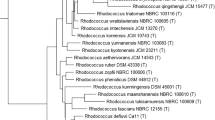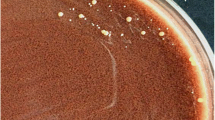Abstract
A 57-year-old Japanese man on peritoneal dialysis developed peritoneal dialysis-associated peritonitis caused by Rhodococcus corynebacterioides. After the introduction of peritoneal dialysis, he had experienced four episodes of peritonitis, but the causative organism was not identified in any of episode. When he was hospitalized for the fifth episode of peritonitis, Rhodococcus corynebacterioides was detected in the ascitic fluid. He improved after an intraperitoneal administration of vancomycin (VCM) that was used based on the treatment of peritonitis caused by Corynebacterium spp. However, he then had repeated flare-ups and eventually required the removal of the peritoneal dialysis catheter due to recurrent peritonitis. 16S rRNA gene sequencing is generally needed to positively identify Rhodococcus corynebacterioides. In this case, we were able to rapidly identify the organism by using mass spectrometry and then apply this knowledge to the patient's treatment. To the best of our knowledge, this is the first reported case of peritoneal dialysis-associated peritonitis caused by Rhodococcus corynebacterioides.


Similar content being viewed by others
References
Majidzadeh M, Fatahi-Bafghi M. Current taxonomy of Rhodococcus species and their role in infections. Eur J Clin Microbiol Infect Dis. 2018;37:2045–62. https://doi.org/10.1007/s10096-018-3364-x.
Sogawa K, Watanabe M, Sato K, Segawa S, Ishii C, Miyabe A, et al. Use of the MALDI BioTyper system with MALDI-TOF mass spectrometry for rapid identification of microorganisms. Anal Bioanal Chem. 2011;400:1905–11. https://doi.org/10.1007/s00216-011-4877-7.
Yassin AF, Schaal KP. Reclassification of Nocardia corynebacterioides Serrano et al. 1972 (Approved Lists 1980) as Rhodococcus corynebacterioides comb. nov. Int J Syst Evol Microbiol. 2005; 55(Pt 3):1345–8. https://doi.org/10.1099/ijs.0.63529-0.
Kitamura Y, Sawabe E, Ohkusu K, Tojo N, Tohda S. First report of sepsis caused by Rhodococcus corynebacterioides in a patient with myelodysplastic syndrome. J Clin Microbiol. 2012;50:1089–91. https://doi.org/10.1128/JCM.06279-11.
Chang YT, Wang HC, Wang MC, Wu AB, Sung JM, Sun HS, et al. Rapid identification of bacteria and Candida pathogens in peritoneal dialysis effluent from patients with peritoneal dialysis-related peritonitis by use of multilocus PCR coupled with electrospray ionization mass spectrometry. J Clin Microbiol. 2014;52:1217–9. https://doi.org/10.1128/JCM.03106-13.
Kaleta EJ, Clark AE, Johnson DR, Gamage DC, Wysocki VH, Cherkaoui A, et al. Use of PCR coupled with electrospray ionization mass spectrometry for rapid identification of bacterial and yeast bloodstream pathogens from blood culture bottles. J Clin Microbiol. 2011;49:345–53. https://doi.org/10.1128/JCM.00936-10.
Barraclough K, Hawley CM, McDonald SP, Brown FG, Rosman JB, Wiggins KJ, et al. Polymicrobial peritonitis in peritoneal dialysis patients in Australia: Predictors, treatment, and outcomes. Am J Kidney Dis. 2010;55:121–31. https://doi.org/10.1053/j.ajkd.2009.08.020.
Schaefer F, Klaus G, Müller-Wiefel DE, Mehls O. Intermittent versus continuous intraperitoneal glycopeptide/ceftazidime treatment in children with peritoneal dialysis-associated peritonitis. The Mid-European Pediatric Peritoneal Dialysis Study Group (MEPPS). J Am Soc Nephrol. 1999;10:136–45. https://doi.org/10.1681/ASN.V101136.
Fish R, Nipah R, Jones C, Finney H, Fan SL. Intraperitoneal vancomycin concentrations during peritoneal dialysis-associated peritonitis: Correlation with serum levels. Perit Dial Int. 2012;32:332–8. https://doi.org/10.3747/pdi.2010.00294.
Stevenson S, Tang W, Cho Y, Mudge DW, Hawley CM, Badve SV, et al. The role of monitoring vancomycin levels in patients with peritoneal dialysis-associated peritonitis. Perit Dial Int. 2015;35:222–8. https://doi.org/10.3747/pdi.2013.00156.
Blunden M, Zeitlin D, Ashman N, Fan SL. Single UK centre experience on the treatment of PD peritonitis – Antibiotic levels and outcomes. Nephrol Dial Transplant. 2007;22:1714–9. https://doi.org/10.1093/ndt/gfm079.
Mulhern JG, Braden GL, O’Shea MH, Madden RL, Lipkowitz GS, Germain MJ. Trough serum vancomycin levels predict the relapse of gram-positive peritonitis in peritoneal dialysis patients. Am J Kidney Dis. 1995;25:611–5. https://doi.org/10.1016/0272-6386(95)90132-9.
Johnson DW. Do antibiotic levels need to be followed in treating peritoneal dialysis-associated peritonitis? Semin Dial. 2011;24:445–6. https://doi.org/10.1111/j.1525-139X.2011.00883.x.
Szeto CC, Chow KM, Chung KY, Kwan BC, Leung CB, Li PK. The clinical course of peritoneal dialysis-related peritonitis caused by Corynebacterium species. Nephrol Dial Transplant. 2005;20:2793–6. https://doi.org/10.1093/ndt/gfi123.
Author information
Authors and Affiliations
Corresponding author
Ethics declarations
Conflict of interest
The authors have declared that no conflict of interest exists.
Human and animal rights
All procedures performed in studies involving human participants were in accordance with the ethical standards of the institutional and/or national research committee at which the studies were conducted and with the 1964 Helsinki declaration and its later amendments or comparable ethical standards.
Informed consent
Informed consent was obtained from the patient included in the study.
Additional information
Publisher's Note
Springer Nature remains neutral with regard to jurisdictional claims in published maps and institutional affiliations.
About this article
Cite this article
Tanaka, Y., Hirai, D., Kawai, Y. et al. Peritoneal dialysis-related peritonitis caused by Rhodococcus corynebacterioides. CEN Case Rep 12, 68–72 (2023). https://doi.org/10.1007/s13730-022-00718-x
Received:
Accepted:
Published:
Issue Date:
DOI: https://doi.org/10.1007/s13730-022-00718-x




